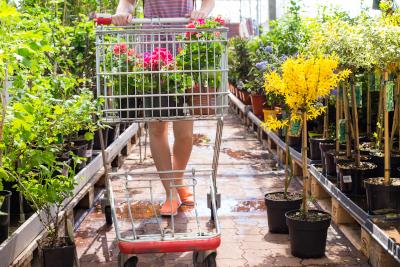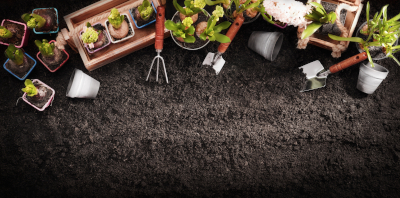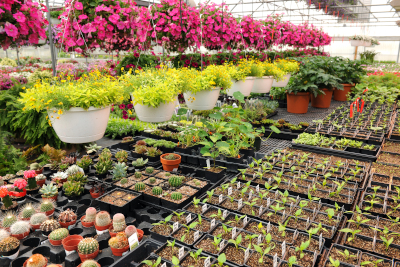
one
two
three



Selecting a new plant for your landscape can be a lot of fun. The plant must look good in the space it is planted, of course, but there are many other factors to consider. Not every plant will grow in a particular spot, no matter how good it would look. Here are some factors to consider that will help your plants to thrive in your garden.
Site Conditions
Site conditions are the environmental factors that affect how plants will grow in the specific space. These conditions are not easy to change, so the right plants must be put in place. Only then will you have a lush, healthy landscape.
Sun or Shade Sun, in this case, is defined as getting at least six hours of sun a day. Partial sun is less than six hours but at least four hours a day, and shade is less than four hours of sun a day. Deep shade is getting less than two hours of sun a day. Shade plants will burn up in full sun, while plants requiring full sun will die in the deep shade.
Wet or Dry How much water does the location get? Does the water linger in this spot, or does it drain quickly? If a spot is boggy, you will have to place bog plants that can tolerate the moisture. If the area almost never gets rain, you need plants that are drought tolerant that will not die of thirst. While an irrigation system can help, it cannot change the drainage rate or reduce the water in a specific location.

Soils The type of soil also factors into the moisture question, but soils do more than that. Clay soil means poor drainage and needs to be amended with lots of organic matter such as compost. Sand can drain too fast, so it also needs lots of organic matter. The soil where you are may be fertile, in which case many plants can grow there, or it may be lacking in nutrients. A soil test can tell you what your soil nutrient content and pH levels are. In our area most soils are heavy in clay, adding compost is a great way to amend the soils to improve drainage and nutrients. This can be done by hand around each plant individually or with a roto-tiller for an entire garden area.
Acid/Alkaline The pH of your soil is important. There are many plants that will only grow on acid soil, such as blueberries, and there are others that will only grow in alkaline soils, such as blackberries. Soil pH can also keep nutrients locked away where the plant cannot use them. Alkaline soils make iron absorption difficult for some plants. Many people get focused on the USDA zone (discussed below) and forget that the soil pH matters, too. Sphagnum peat moss is often suggested as a soil amendment to decrease soil pH and is often used when planting azaleas, rhododendrons, and hydrangeas.
Plant In Layers
When creating a landscape, you do not want all the plants to be the same height. In nature, tall trees give way to smaller trees. Shrubs give way to shorter plants, and groundcovers are the shortest of all. Choosing a mixture of heights makes the landscape more complex and pleasing to the eye. Remember to put the tallest plants at the back and work your way down with the shortest plants in the front.
Variety
Landscapes look best when they feature a variety of plants. Having the exact same thing in every flower bed, for example, becomes monotonous. Here are some things to consider while mixing things up a bit.
Size As mentioned above, it is a good idea to plant in layers. More than that, you must consider how tall and wide the mature plant will be. If you plant a large tree too close to your house, it will damage the foundation with its roots. Small plants can be overwhelmed and shaded out by bigger plants. Make sure there is space for all the plants you are putting in.
Shape (habit) Each plant grows in a certain way. Some plants are very vertical, while others are mounds. Still others stay close to the ground or grow up structures as a vine. This is especially important when planting in a container. You want a thriller, or the showiest plant in the container, spiller, or a plant that will grow over the edge of the container, and fillers, which are the rest of the plants in the container. Too many thrillers, and they get in the way of each other.
Texture How does the plant feel when you touch it? A cactus has one texture, a hard and prickly one. Lamb’s-ear, an herb, feels as soft and furry as a lamb’s ear. There are many textures in between. This is especially important in shade gardens, where everything tends to be a shade of green. The different textures of ferns and hostas break up the monotony of the greens in the shade.

Color This is the easiest feature to focus on. You want a variety of colors but need to make sure that colors either go together or are deliberately contrasting. Use a color palette to paint your landscape. That way, even if you have a favorite color, you can use lots of different shades of plants in that color.
Seasonality Flowers bloom for different amounts of time. Some bloom once, while others bloom in spring and don’t stop until the first frost. Make sure that you pick plants that bloom at different times all through the growing season. Not only does this mean your landscape is always interesting to look at, but it also helps pollinators such as bees and butterflies find food during the year.
Contrast Sprinkle in some contrasting plants to liven a flower bed or landscape up. For example, the Japanese maple has brilliant red foliage all year. It contrasts nicely with green or gold trees and shrubs.
Formal vs Informal
Some gardens are very formal. They have a plan, with every plant in its place. Trees and shrubs tend to be sculpted without a branch out of place. They may be trimmed into topiaries of various things. Other gardens also have a plan, but plants are not shaped as formally and are allowed to grow into their natural forms. If you have a large landscape, you may have both. For example, you may have a formal cottage garden and an informal flower bed.
Maintenance
When picking plants for your landscape, remember to consider how much work a particular plant will be. Does it need pruning, or does it grow into its space naturally? Will your flowering plants need deadheading in order to continue to bloom? How much and how often will you have to water this plant? After it gets established, will it still need supplemental water? Landscapes are to be enjoyed. Will you enjoy this plant, or will it become a chore to take care of?
Hardiness
This is essentially whether your plant will survive the temperature extremes in your landscape. The USDA hardiness zones are helpful to see if your plant will manage the winter. The USDA zones do not tell you if the plant will survive the summer in your landscape. Always read the tag or catalog to see if the plant you want will grow in your zone. Zones can be deceptive, however, as plants can have the same hardiness zone but different pH needs, watering needs, etc.
Who knew there are so many factors to consider when choosing landscape plants? Royal Creations Architectural Landscaping can help. We have many years of experience choosing and planting landscapes. We know what will grow here and what will not. Contact us for expert guidance in choosing plants for your landscape. We can maintain your landscape planting beds, too. Contact Royal Creations Architectural Landscaping today for expert advice and assistance.